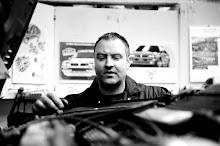
Possible cause of oil starvation? Yes I think so.
On removing the bearing caps all the shell bearings were completely shot. After conferring with the owner It was agreed that I remove and strip down the engine to assess it and more delights were revealed: Scored bores, pistons, crank journals and oil pump, various bits missing from the external of the engine such as strengthening plates, spacer bobbins, bolt heads snapped off:
Some old piece of water pipe from another car with the wrong angle on it was hardly going to let the cooling water flow very well.

One of the blanking bungs for the gearbox was badly mangled and rolling up and down the dashboard, why this had been removed we'll never be entirely sure, to fill the gearbox with oil maybe? Either way it never made it back to where it previously lived as a bit of rag had been stuffed in there instead.
Best of all, one lobe from each of the cams partially missing. Only just worn like this? Nope, the corresponding shim was about as thick as my house doorstep so the builder must or should have known.
The block had been painted quite nicely though.
After much more conferring, a spec was agreed on and the task of rebuilding it properly began. Basically it was to be running stock power for now, but with uprated components built into the block so it could be safely modified by 'bolt ons' at a later date when funds allowed.
New steel rods and forged pistons were specced, a checked good used crank had its journals polished, core plugs knocked out and was left in the dip & strip tank for a few hours before being high pressure washed and dried off. It was mated to a new steel flywheel, paddle clutch with high pressure plate and sent off for balancing along with the pistons and rods. I have found the OE cranks to be quite well balanced from the factory and only needing a bit of a tickle here and there on the counterweights to make them perfect, they do however need all the other components bolting to them and balancing properly by someone who has the right equipment and knows how to use it. The steel flywheels we sell are already balanced, but clutch pressure plates rarely are and need a fair amount of attention.
Balancer shafts
People talk about "2nd order alternating inertial forces" quoting it from the Lancia manual or some online text without knowing exactly what it means, the best explanation I have ever come across is here:
http://en.wikipedia.org/wiki/Balance_shaft
To simplify what they are saying is that in a four cylinder engine the pistons aren't in exactly the opposite places at the same time in the four stroke cycle so can't cancel out the forces caused by each other. There will always be some vibration, but the engine is mounted on floppy rubber bushes so will you feel it? Not really.
As outlined in the aforementioned article, the two litre capacity is borderline size for needing balancer shafts. So the advantage of BS on an otherwise unmodified engine is just singularly to reduce some vibration of a not completely properly balanced production engine and no more.
What about the advantages of removal? Well the centre bearing shells are no longer available and when worn will leak oil reducing the overall oil pressure, removing, blocking these and the other associated oilways off will see a big improvement in oil pressure and reliability.
There is an increase in engine power and response. Servicing is easy and cheaper due to less belts and bearings. Reliability goes up due to increased oil pressure and less moving parts to fail.
Interestingly the balancer shafts changed weight over the years, the last ones used in the Fiat Coupe were different compared to of the early ones in the 8v, this was done by machining more or less out of shaft along its length which must have altered its balance too, I do wonder why...
Knocking out old bearing shells:
The guys smile when they came to pick it up made it worthwhile, they plan on running it in then just getting some use out of it on the road and doing some sprints. More modification will follow when needed, but just for now they were happy to get the car back with a good reliable strong bottom end.

